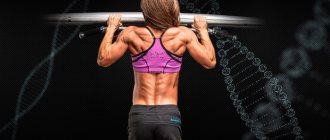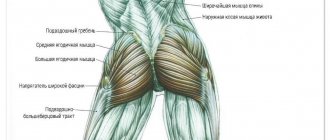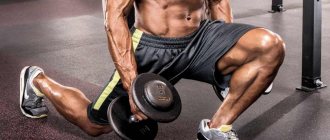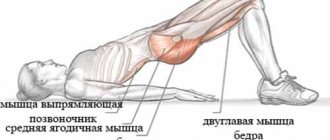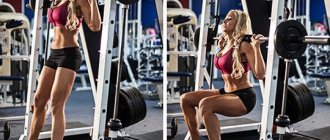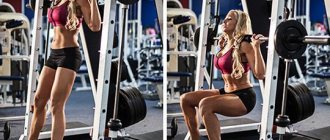Gluteus medius: dimples of Venus and Trendelenburg gait
The gluteus medius abducts the hip (swinging legs to the side) and also stabilizes the pelvis during dynamic activities such as walking and standing on one leg. When this muscle is weak, a characteristic Trendelenburg gait occurs: when walking or stepping on one leg, the affected side of the pelvis seems to fall down, because the gluteal can no longer hold it.
Participation in sports[edit | edit code]
The gluteus medius muscle is one of the most important hip abductors and stabilizes the hip joint and pelvis on the side of the supporting leg through isometric contractions during race walking, running and single-leg stand. This muscle is involved in movements in many sports (all sports with elements of running - triple jumps, fencing, contact sports, artistic gymnastics, figure skating and speed skating). In addition, with a fixed pelvic girdle, the hip is dynamically abducted, which is required in sports such as artistic gymnastics, figure skating, breaststroke, and various contact sports. The front part participates in the work of the flexors and internal rotators of the hip (during breaststroke). The posterior part contracts jointly with the hip extensors and external rotators and contributes to the action of the gluteus maximus in figure skating, gymnastics, discus throwing, and contact sports.
| Kind of sport | Movement/hold | Function | Load | Types of abbreviations |
| All running disciplines (triple jumps, fencing, contact sports, artistic gymnastics, figure skating, speed skating) and one-leg stand | Contractions on the side of the supporting leg | Hip extension, stabilization of the pelvis on the side of the supporting leg during abduction | Fast, explosive, strength endurance | Dynamic concentric and static |
| Gymnastics | Exercise “scissors” on horseback, jump “legs apart” on the crossbar, uneven bars, handstand | Hip abduction | Fast, explosive, power endurance | Dynamic concentric |
| Figure skating | Leg abduction | Hip abduction | Power endurance | Dynamic concentric |
| Swimming | Swimming breaststroke, leg raises | Hip abduction | Power endurance | Dynamic concentric |
| Contact sports (such as karate) | Holding your leg while kicking | Hip abduction | Fast, explosive | Dynamic concentric |
| Sprint, cross-country skiing, speed skating, long jump, high jump, pole jump, triple jump, fencing, figure skating (jumping), artistic and sports diving, artistic gymnastics, cycling | Anterior: Hip flexion (see Rectus femoris) | |||
| Gluteus maximus muscle | Posterior: extension, hip external rotation (see Gluteus Maximus) |
Gluteus medius muscle
The gluteus medius is a muscle of the outer group of pelvic muscles.
Located under the gluteus maximus muscle. The shape is close to a triangle. The muscle is thick, and there are two layers of bundles - superficial and deep. The muscle bundles are arranged in a fan-shape, starting with a wide part from the outer surface of the wing of the ilium, limited in front by the anterior gluteal line, above by the iliac crest, and below by the posterior gluteal line. Then all muscle bundles converge into a common powerful tendon, attached to the apex and outer surface of the greater trochanter
Function of the gluteus medius muscle
Participates in hip abduction; when the hip is in a fixed position, it abducts the pelvis to the side. Straightens the torso bent forward, when standing, tilts the torso in its direction. The anterior muscle bundles rotate the thigh inward, the posterior ones - outward.
Read also[edit | edit code]
- Muscles - anatomy and functions
- Leg muscles
- Hamstring muscles
- Legs - exercises and training features
Muscles around the hip joint
- Gluteus maximus muscle
- Sartorius
- Iliopsoas muscle
- Gluteus minimus
- Tensor fascia lata
- Pectineus muscle
- Adductor muscles
- Adductor longus muscle
- Adductor brevis muscle
- Adductor magnus muscle
- Gracilis muscle
- Superior gemellus
- Gemini inferior muscle
- Obturator internus muscle
- Obturator externus muscle
- Quadratus femoris
- Piriformis muscle
Gluteus minimus
the deepest of the three, also involved in hip abduction and torso straightening. It starts from the outer surface of the ilium wing between the anterior and inferior gluteal lines, and attaches to the anterior edge of the greater trochanter of the femur.
The structure of the gluteus minimus muscle
The shape resembles the gluteus medius muscle, but is much thinner in diameter. Covered throughout. It starts from the outer surface of the wing of the ilium, between the anterior and lower gluteal lines. Then the muscle bundles converge and pass into a tendon that attaches to the anterior edge of the greater trochanter of the femur.
Function of the gluteus minimus muscle
Similar to the function of the gluteus medius muscle. When contracting, the hip abducts. When supporting the body on one leg, it tilts the pelvis in its direction.
See also:
- Exercises for leg muscles
- How to pump up your thigh muscles
- How to pump up your buttocks
Anatomy
The largest muscle is the gluteus maximus. It is located closest to the skin and is responsible for the appearance and aesthetics of the buttocks, since it determines how much this part of the body will protrude. Its structure is diamond-shaped, wide and fleshy.
The abnormally large size of the muscle tissue of the buttocks is a characteristic feature of the structure of the muscles of people, and it is this that allows a person to hold his torso straight upright. Structurally, a large muscle consists of coarse fibers that are collected in bundles and are parallel to each other. These bundles are connected into one large one, but at the same time they are separated by partitions consisting of fibers.
The gluteus maximus muscle originates in the area of the ilium (specifically the back of it) and is located directly above and behind the iliac crest. It then runs along the lower part of the sacrum away from the coccyx. The fibers are directed downward and sideways, forming with the external fibers most of the muscle in its lower part. Next, the muscle bypasses the greater trochanter of the femur and turns into a wide shell. The deep-seated fibers in the lower part of the muscle are located between the vastus lateralis and adductor muscles.
The gluteus maximus muscle is one of the main muscles used in sports such as hockey, basketball, football or volleyball. Its stretching can be very painful and take a long time to resolve.
Types of exercises
There are two general groups of exercises for the gluteal muscle:
- With or without weights.
- Basic or isolated.
When performing exercises, the main thing is not to forget about the execution technique. If it is violated, instead of the gluteus maximus muscle, you risk increasing the volume of the quadriceps muscle. But even more serious consequences of incorrect exercises are disruptions in the functioning of the joints, which can lead to injuries to the gluteus medius muscle.
Dumbbells and barbells serve as weights. The weight and type of weighting depends on the training level of the trainee. When working with them, the technique should not be disrupted, and the muscles should be felt working.
The basis of any training aimed at correcting the gluteus maximus muscle should be basic exercises. The most effective ones are lunges, squats, split squats and deadlifts.
Squats are one of the most effective and difficult exercises in terms of technique. To master it, you need a weighting device of the smallest weight (for example, a bar without a load).
Deadlifts can be performed with heavier weights and help improve the appearance of the gluteal region since even the gluteus minimus will be engaged.
When working on the muscles of the pelvic area, you can use not only weights, but also various exercise equipment and auxiliary items. A split squat is a lunge with the non-working leg placed on a bench.
For more detailed, targeted correction of the muscles of the buttocks, so-called isolated exercises are used. They are performed after the basic ones. These include: lifting the pelvis, pressing, abducting the legs to the side.

Improving the muscles of the buttocks
Today, a sports lifestyle has become widespread, it has become fashionable to maintain one’s physical shape and tone the entire body. And if for the most part we are talking in this case about the aesthetic component and increasing physical strength, then with regard to the gluteal muscles the situation looks different - a lack of muscle mass in this area causes atrophy of the legs, a person cannot stand, walk or squat for a long time.
The functions of the gluteal muscles are very diverse. Changing the appearance, shape and volume of muscles is possible only through persistent and regular training (if we talk about natural changes, and not surgical intervention, for example).
Training program for men and women
Correct mistake
Buttocks
are the most attractive part of the human body. As psychologists have established, men primarily evaluate their buttocks and chest, while girls are intuitively interested in the width of their shoulders and the volume of their buttocks.
According to anthropologists, the buttocks are one of the main factors of attractiveness for both men and women because they reflect a person's ability to run long distances, which was an important evolutionary factor for survival.
A 2015 study by a team from King's College London found that developing leg strength could improve brain function as you age.
In a 2021 study, British scientists concluded that larger buttocks have a positive effect on the health and intelligence of women due to the high content of omega-3 fatty acids in the lower body.
additional approaches must be used.
(in order of importance).
If you are overweight:
If you have a thin build:
Anatomy of the buttocks and pelvis
Anatomy of the gluteal muscles: side viewAnatomy of the gluteal muscles
To choose the right exercises for the buttocks, you need to know their anatomy and morphological features well.
Women's pelvis naturally has a slightly greater forward tilt than men's, which increases the lumbar lordosis of the spine and emphasizes the convexity of the buttocks. Poor posture and weakened hamstrings also cause the buttocks to appear disproportionately large.
The buttocks are formed by three main muscles:
- The gluteus maximus
is the largest and most prominent of the gluteal muscles. It has a diamond shape and is located above all other gluteal muscles; it plays a large role in fixing the torso and hip extension. - The gluteus medius
is a small muscle that sits laterally on top of the gluteus maximus. It is visible when viewed from the side or behind. The gluteus medius muscle works in hip abduction and in exercises that involve the pelvic area; its anterior bundles are involved in inward rotation of the thigh, and its posterior bundles are involved in movements where the thigh rotates outward. - The gluteus minimus
is a small muscle located laterally under the gluteus maximus and is therefore not visible at all. The function of the gluteus minimus muscle is similar to that of the gluteus medius. The gluteus minimus muscle is worked during leg movements and all movements that involve the pelvic area and torso.
The glutes support the hamstrings when you need to increase your speed. When you walk slowly they barely work. But when you speed up and start running, your buttocks are actively involved in the work.
The gluteal muscles help the quadriceps to extend and rotate the thigh outward, and together with the muscles of the back of the thighs, they extend the torso from a tilted position. In addition, they tilt the body to the side.
Helpful advice
Lack of mass in the gluteal muscles automatically means their weakness, and with it low results in all leg exercises, from squats to jumping and running.
If you sink into squats with a barbell on your shoulders, but cannot get up, this suggests that you should equally increase the strength of your quadriceps and buttocks. Leaving the glutes alone means reducing the lifting force by almost half.
Shapes of female buttocks: 1. Inverted “V”; 2. Square; 3. Round; 4. “Heart” An easy way to instantly “pump up” your buttocks
Basic exercises for pumping up the buttocks
The gluteus maximus muscles are well worked when performing basic leg exercises - squats, lunges and deadlifts.
But for the medium and small bundles of the gluteal muscles, you need to perform special exercises - swinging your legs in a block device, or with leg weights.
To fully work out the “minor” muscles of the gluteal region, you need to perform these exercises both in a standing position and lying on your side.
Exercises for the gluteus maximus muscle
Exercises for the gluteus medius and minimus muscles
Read more:
Exercises for buttocks and legs
The role of exercise
Different exercises for pumping up the gluteus maximus muscle have different goals: you can either increase their volume or correct their shape. Increasing volume does not seem to be a particularly difficult task; this does not require any special methods or training programs; regular performance of tasks to maintain muscle tone is sufficient. If we are talking about visual correction, then it is necessary to work on each individual bundle of muscle tissue fibers, for which whole sets of various exercises are performed. The gluteus medius muscle is also involved in them.
The most effective exercises are squats, lunges and deadlifts. And if the first two types of exercises can be done without special equipment, then the latter can only be done in the gym.
